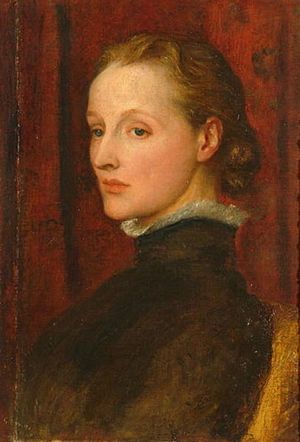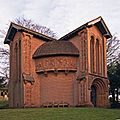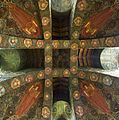Mary Fraser Tytler facts for kids
Quick facts for kids
Mary Seton Watts
|
|
|---|---|

Mary Fraser Tytler painted by G. F. Watts
|
|
| Born |
Mary Seton Fraser Tytler
25 November 1849 India
|
| Died | 6 September 1938 (aged 88) |
| Nationality | Scottish |
| Education |
|
| Known for | Painting, Ceramics |
| Movement | Gothic Revival Art Nouveau |
| Spouse(s) |
George Frederic Watts
(m. 1886) |
Mary Seton Watts (born Mary Seton Fraser Tytler, 1849–1938) was a talented artist, designer, and social reformer. She used symbols in her art to express ideas. She was also known for her work in crafts and for helping communities.
Contents
A Look at Mary Watts' Life
Early Life and Art Training
Mary Seton Fraser Tytler was born in India on November 25, 1849. Her father worked for the East India Company. She spent her childhood in Scotland, living with her grandparents. In the 1860s, she moved to England.
Mary began her art studies in Dresden in 1870. Later that year, she joined the South Kensington School of Art. From 1872 to 1873, she studied sculpture at the Slade School of Art. She first became known for painting portraits.
Marriage and Social Work
Mary met the famous painter George Frederic Watts in Freshwater. She married him on November 20, 1886, in Epsom, Surrey. She was 36 years old, and he was 69.
Mary Watts was very active in social causes. She was the president of a local group that supported women's right to vote. This group was part of the National Union of Women's Suffrage Societies. She even held meetings about women's suffrage in Compton, Surrey.
Mary Watts passed away at her home in Compton on September 6, 1938. She is buried in the Watts Chapel, a special place she helped create.
Mary Watts' Artistic Creations
Art and Craftwork
After her marriage, Mary Watts focused on different types of art. She created bas-reliefs, which are sculptures that stick out slightly from a flat surface. She worked with pottery, metal, and textiles. Her art often featured Celtic and Art Nouveau styles.
Mary helped start the Compton Potters' Arts Guild and the Arts & Crafts Guild in Compton, Surrey. These groups helped people learn and practice traditional crafts.
The Watts Mortuary Chapel
One of Mary Watts' most famous projects is the Watts Mortuary Chapel in Compton. She designed, helped build, and looked after this chapel from 1895 to 1904. She also helped build the Watts Gallery (1903–04) to keep her husband's artwork safe.
Mary showed her work at The Woman's Building in Chicago in 1893. This was part of the World's Columbian Exposition, a big fair.
Helping Communities with Crafts
Mary Watts believed in helping rural communities. Through the Home Arts and Industries Association (HAIA), she worked to create jobs by keeping traditional handicrafts alive. While building the Watts Mortuary Chapel, she taught people how to model clay. This led to the Compton Potters' Guild starting in 1899.
She strongly believed that anyone could create beautiful things. She felt everyone should have a craft to express themselves. Mary supported the revival of the Celtic style, which was an old art form from Scotland and Ireland. In 1899, she designed Celtic-style rugs for a company called Alexander Morton & Co. This company worked with the Congested Districts Board for Ireland to employ women in Donegal, Ireland, who needed work.
Mary Watts was a leader in developing Liberty's Celtic style. Many of her designs for the Watts Mortuary Chapel were used for Celtic Revival carpets, book covers, metalwork, and textiles for Liberty & Co..
Writings by Mary Watts
Later in her life, Mary Watts wrote a book called The Word in the Pattern (1905). This book explains the symbols she used in the Watts Mortuary Chapel. She also wrote a three-volume biography about her husband, called Annals of an Artist's Life (1912).
See also
 In Spanish: Mary Fraser Tytler para niños
In Spanish: Mary Fraser Tytler para niños
Images for kids








